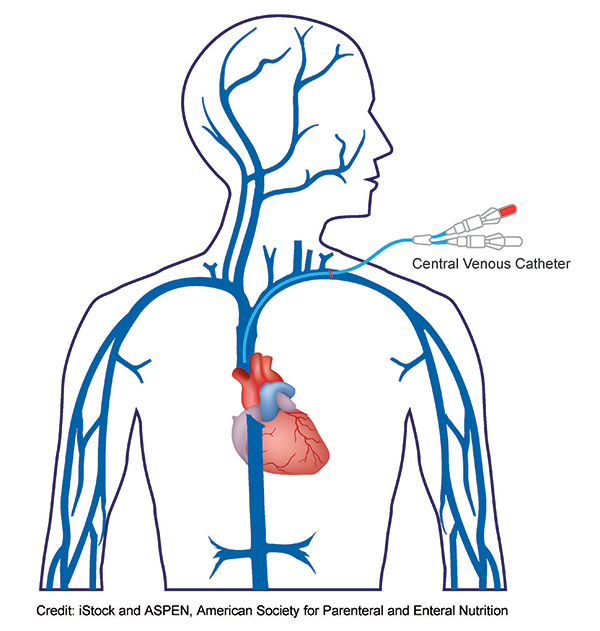Parenteral nutrition (Parenteral [pah REN ter ul] Nutrition) (PN) is a way patients receive nutrition when they cannot use the gastrointestinal (GI) tract or nutrition needs cannot be met through the GI tract alone. Parenteral nutrition is a unique sterile intravenous (IV) solution that is given directly into the bloodstream via a catheter that is inserted into a vein. Each PN admixture is specifically formulated to meet a patient’s unique nutrition needs. Parenteral nutrition contains all of the fluid, protein, carbohydrate, fat, vitamins, minerals, and other nutrients needed to meet nutrition needs. It was once called total parenteral nutrition (TPN) or hyperalimentation .
What types of IV catheters are used to administer PN?
Parenteral nutrition may be delivered via two different types of IV catheters:
- Central IV catheter: a large-diameter high-flow vein, usually in the chest near the heart. If PN is to be administered as a concentrated solution or for more than a short time, this is the preferred route.
- Peripheral IV catheter: small-diameter peripheral vein, usually in the hand or forearm. This is reserved for short-term administration only.

Who can receive PN?
Patients of all ages (neonates, infants, children, adolescents, and adults) can receive PN. Thousands of patients receive PN yearly in acute care settings, and many continue PN at home or in long-term care facilities.
When is PN indicated?
Parenteral nutrition is given to patients who are unable to meet nutrition needs through the GI tract. Parenteral nutrition is often given to those with moderate to severe GI diseases and those individuals who cannot properly digest or absorb food, such as short bowel syndrome, GI fistulas, or bowel obstruction.
What are the primary benefits of PN?
PN is a lifesaving or life-sustaining therapy. Parenteral nutrition provides the nutrients required when a person cannot consume enough food or nutrients by mouth or through the GI tract. Additionally, when EN is unable to provide patients with the required nutrients, PN is an optimal choice, especially during recovery from a disease, illness, or condition. Patients can become malnourished without proper nutrition and develop adverse conditions such as infections or even death. Parenteral nutrition provides the nutrients needed for proper body functions and overall well-being. Parenteral nutrition can also prevent the development of malnutrition.
Are there side effects of PN?
Although life-sustaining/lifesaving, PN may be associated with some side effects. The side effects are dependent upon how long an individual remains on PN. Side effects may include:
- Metabolic issues such as electrolyte imbalances, acid-base abnormalities, and glucose intolerance
- Hypertriglyceridemia
- IV catheter-related infection and other infectious complications
- Thrombosis
- PN-associated liver disease
Side effects can usually be prevented or managed with appropriate monitoring and intervention.
For how long does a person require PN?
Patients can live well on PN for as long as needed. Parenteral nutrition is often used briefly and then decreased or discontinued when the patient switches to EN, nutritional needs are met via the GI tract or eats enough by mouth. Some patients may need PN lifelong.
How is PN prepared?
Parenteral nutrition is prepared by a pharmacist in a sterile environment in a specialized pharmacy. Each PN solution is prepared to meet the patient’s unique nutrition needs. Parenteral nutrition solutions may be individually compounded or commercially available as a multi-chamber PN product. Compounded PN is when the pharmacist combines individual nutrients into a solution in the specialty pharmacy room. Another form of PN is called a multi-chamber bag (MCB-PN), where a commercial manufacturer prepares most of the PN ingredients into a two or three-chamber bag, and the pharmacist combines those ingredients and generally adds vitamins and trace elements.
How is PN administered?
The PN admixture is attached to an IV pump that infuses the PN at a specific rate. Parenteral nutrition can be administered continuously (i.e., over 24 hours) or as a cycle (i.e., generally over 10-18 hours). In the hospital setting, a nurse administers the PN to the patient. In the home setting, PN is generally administered by a caregiver or the patient.
What does follow-up care and monitoring(e.g., medical team, patient/home healthcare, and dietitian care) of PN entail?
If a person goes home on PN, follow-up appointments with a healthcare provider and NSPS will be scheduled. At these visits, weight and nutrition status will be monitored to determine if adjustments are needed in the PN regimen. Sometimes, a home care nurse or dietitian will schedule home visits for additional follow-up monitoring.
Disclaimer: This content has been developed for use by healthcare professionals to inform other clinicians and/or patients/caregivers. ASPEN is making this content available for informational purposes only. This content is not based on ASPEN Board Approved documents and should not be confused with ASPEN clinical guidelines as it was not developed according to ASPEN guideline processes. Recommendations provided here do not constitute medical or other professional advice and should not be taken as such. To the extent that the information presented here may be used to assist in the care of patients, the primary component of quality medical care is the result of the professional judgment of the healthcare professionals providing care. The information presented here is not a substitute for the exercise of professional judgment by healthcare professionals. Circumstances and patient specifics in clinical settings may require actions different from those recommended in this document; in those cases, the judgment of the treating professional should prevail. Use of this information does not in any way guarantee any specific benefit in outcome or survival. This tool is intended to supplement, but not replace, professional training and judgment.